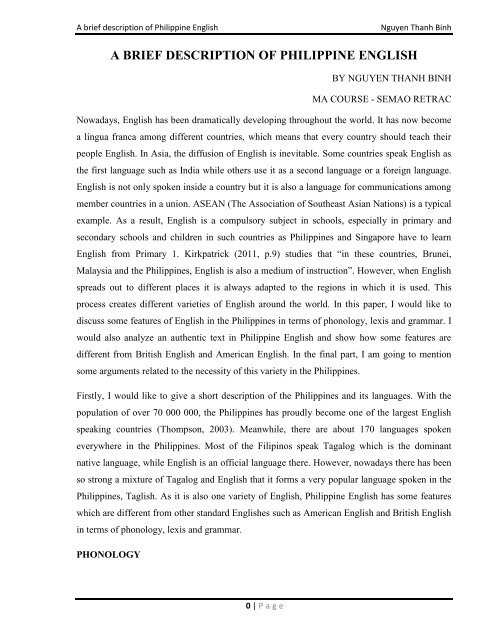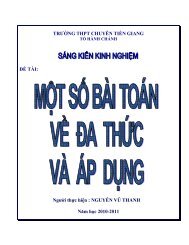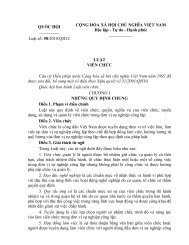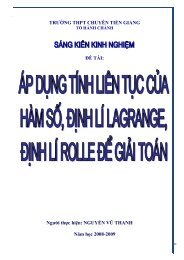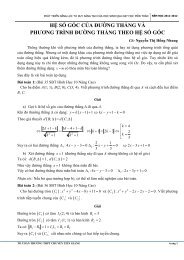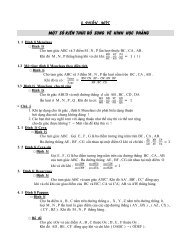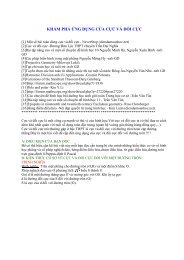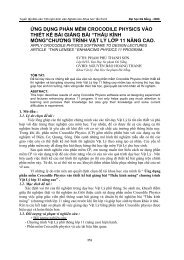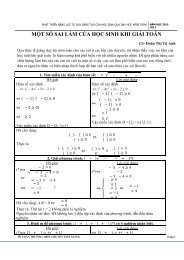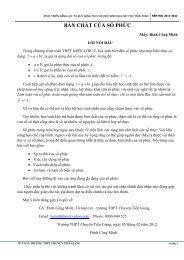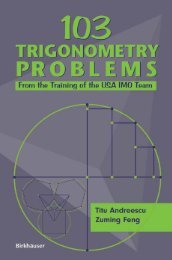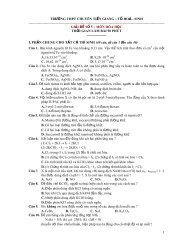A BRIEF DESCRIPTION OF PHILIPPINE ENGLISH
A BRIEF DESCRIPTION OF PHILIPPINE ENGLISH
A BRIEF DESCRIPTION OF PHILIPPINE ENGLISH
Create successful ePaper yourself
Turn your PDF publications into a flip-book with our unique Google optimized e-Paper software.
A brief description of Philippine English Nguyen Thanh Binh<br />
A <strong>BRIEF</strong> <strong>DESCRIPTION</strong> <strong>OF</strong> <strong>PHILIPPINE</strong> <strong>ENGLISH</strong><br />
0 | P a g e<br />
BY NGUYEN THANH BINH<br />
MA COURSE - SEMAO RETRAC<br />
Nowadays, English has been dramatically developing throughout the world. It has now become<br />
a lingua franca among different countries, which means that every country should teach their<br />
people English. In Asia, the diffusion of English is inevitable. Some countries speak English as<br />
the first language such as India while others use it as a second language or a foreign language.<br />
English is not only spoken inside a country but it is also a language for communications among<br />
member countries in a union. ASEAN (The Association of Southeast Asian Nations) is a typical<br />
example. As a result, English is a compulsory subject in schools, especially in primary and<br />
secondary schools and children in such countries as Philippines and Singapore have to learn<br />
English from Primary 1. Kirkpatrick (2011, p.9) studies that “in these countries, Brunei,<br />
Malaysia and the Philippines, English is also a medium of instruction”. However, when English<br />
spreads out to different places it is always adapted to the regions in which it is used. This<br />
process creates different varieties of English around the world. In this paper, I would like to<br />
discuss some features of English in the Philippines in terms of phonology, lexis and grammar. I<br />
would also analyze an authentic text in Philippine English and show how some features are<br />
different from British English and American English. In the final part, I am going to mention<br />
some arguments related to the necessity of this variety in the Philippines.<br />
Firstly, I would like to give a short description of the Philippines and its languages. With the<br />
population of over 70 000 000, the Philippines has proudly become one of the largest English<br />
speaking countries (Thompson, 2003). Meanwhile, there are about 170 languages spoken<br />
everywhere in the Philippines. Most of the Filipinos speak Tagalog which is the dominant<br />
native language, while English is an official language there. However, nowadays there has been<br />
so strong a mixture of Tagalog and English that it forms a very popular language spoken in the<br />
Philippines, Taglish. As it is also one variety of English, Philippine English has some features<br />
which are different from other standard Englishes such as American English and British English<br />
in terms of phonology, lexis and grammar.<br />
PHONOLOGY
A brief description of Philippine English Nguyen Thanh Binh<br />
In general, the Philippine English phonology is not different from that of American English.<br />
However, there are still some acceptable differences in allophones. Philippine English is rhotic,<br />
meaning that the Filipinos always pronounce the sound “r” after a vowel similar to Scottish or<br />
American English since it is based on the American phonology. Some consonants such as /d, t,<br />
l, n/ have a dental articulation rather than an alveolar one (Millward and Hayes, 2011).<br />
Moreover, there are some sounds which never exist in Philippine phonological system such as<br />
interdental /ð/ and /θ/. These two sounds are often pronounced /d/ and /t/ so than and thanks are<br />
spoken as /dæn/ and /tænks/. Like /ð/ and /θ/, /v/ and /f/ is not existent in most of the native<br />
languages, so they are often replaced with /b/ and /p/ like vase pronounced as /bɑː z/ and fence<br />
pronounced as /pens/ though some native minorities that have little contact with Spanish will<br />
have more correction that the others. Interestingly, some people even have a hypercorrection<br />
that they pronounce all words beginning with /b/ and /p/ as /v/ and /f/. Due to great influence<br />
from Spanish, the pronunciation of some sounds is just like Spanish. For example, stream,<br />
stress and strong with the paired consonants /st/ at the beginning are usually spoken as<br />
istream/estream, istress/estress, istrong/estrong. In addition, some similar vowels are usually<br />
treated with the same pronunciation. For example, it will be very difficult for a person to<br />
distinguish between these minimal pairs: feel / fill, full / fool, top / tap. The diphthong /əʊ / is<br />
also spoken as /o:/ so phone will be spoken as /fo:n/ rather than /fəʊ n/. Philippine English is<br />
also considered syllable-timed rather than stress-timed. Therefore, instead of pronouncing the<br />
unstressed syllables as a schwa, the Filipinos tend to pronounce them with even beats just like<br />
stressed syllables. This reflects “the fact that Filipinos typically learn English from books rather<br />
than from native speakers of the language” and “through reading or dictionary work than from<br />
conversation with Americans” (Thompson, 2003, p.52-53). The typical examples are the<br />
pronunciations of these sounds establísh, diplomatícally, cemetéry, and necessáry. Gonzalez<br />
(1997, p.32-33) suggests the tables of the vowel and consonant sounds of cultivated Philippine<br />
English as follows:<br />
The vowel and consonant sounds of cultivated Philippine English<br />
1 | P a g e
A brief description of Philippine English Nguyen Thanh Binh<br />
LEXIS<br />
“The vocabulary of Philippine English derives from a range of phenomena including semantic<br />
and part-of-speech shift, loan translations, coinages and creative innovations, compounds and<br />
hybrids” Kirkpatrick (2007, p.31). For example, the use of colgate, meaning “toothpaste”<br />
proves the sematic conversion from a name to a general word. Also, grandfather can be<br />
understood as “an uncle of one's father or mother” while bold means “nude”. Part-of-speech<br />
shift can also be seen by the change of the function of some words in a sentence or an utterance.<br />
For example traffic can be used as an adjective as in the sentence “the street is so traffic!” Due<br />
to Spanish colonization of over three centuries, it is easy to find borrowed words from Spanish.<br />
For instance, merienda means “a light meal or snack especially in the afternoon, similar to the<br />
concept of afternoon tea” and encargado means “person in charge of a property”. Besides,<br />
Tagalog is mostly spoken in the Philippines so there are a great number of borrowed words<br />
from this native language such as carabao meaning “water buffalo” and boondock meaning<br />
“mountain”. The loan translation can be easily seen by the examples taken from Thompson<br />
(2003, p.53-54). Eggs means „testicles‟ because in Spanish the slang huevos means “eggs,<br />
testicles” and open the radio means “turn on the radio” because in Tagalog, the verb buksan<br />
means “open/turn on an electrical appliance”. Coinages and creative innovations are proven in<br />
2 | P a g e
A brief description of Philippine English Nguyen Thanh Binh<br />
such examples as carnap meaning “steal a car” and Gets? meaning “Understand?”. Compounds<br />
consists of comfort room (toilet, restroom), hold-upper (someone engaged in armed robbery)<br />
and hand carry (carry-on luggage when flying commercial aircraft). The compounds of words<br />
from different languages known as hybrids are also very common such as colegiala English<br />
(college English), balikbayan box (a ubiquitous corrugated box containing any number of small<br />
items and sent by an overseas Filipino known as a “balikbayan”) and buko juice (the juice of a<br />
young coconut).<br />
GRAMMAR<br />
One of the noted grammatical features in Philippine English is the missing of subject-verb<br />
agreement in present tenses as in the sentences “He go to school. His mother give him money to<br />
buy a book.” In some cases, they sometimes use present perfect instead of past simple as in the<br />
sentence Yesterday I have met him and past perfect instead of present perfect or past simple as<br />
in the sentences “Have some pupils tell they class what they had observed” (Pena, 1997, p.92)<br />
and “… Sen. Francis Pangilinan had already started sponsoring the proposed … Act”<br />
(Pankratz, 2004, p.80). Besides, there is also overuse of present continuous tense to refer to<br />
habits and routines as in the sentence He is going to school by bus every morning. Some<br />
transitive verbs are also treated as intransitive verbs as in the sentences I don’t like. I can’t bear.<br />
Do you enjoy? In addition, Filipinos prefer to use auxiliary verbs in present tense to those in<br />
past tense. For example, instead of saying “He said he had finished the test.”, they would prefer<br />
to say “He said he has finished the test.” Determiners are also be used in a very different way.<br />
They usually prefer “the Manuel Quezon University” to “Quezon University” and “the food” to<br />
“food” while they often say “United States” rather than “the United States”. It is concluded that<br />
these features does not match standard British or American English. Also, demonstratives rarely<br />
match with their nouns such as “this pens”. Some non-count nouns are treated as count nouns<br />
as in “You have a beautiful hair!” or “a research”. Kirkpatrick (2007) also looks at one<br />
investigation into distinctive features of Philippine English from Bautista (2005) and mentions<br />
three special features from her research. First, Bautista (2005) discovers that Filipinos favor to<br />
use the structure “one of the SINGULAR NOUN” as in “That’s one of the related problem we<br />
will be discussing”. Second, Filipinos do not also use an article before the word majority as in<br />
“But a survey done by Pulse Asia shows majority of their respondents want President Estrada<br />
3 | P a g e
A brief description of Philippine English Nguyen Thanh Binh<br />
to keep his post”. Third, in spoken English, the usage of “wherein” is frequent as in “This<br />
practice is still being done in several universities in the US ok wherein they have a quota for<br />
different racial groups”.<br />
McKaughan (1993, p.52) commented that “Philippine English has emerged as an autonomous<br />
variety of English with its own self-contained system.” It proves that Philippine English has<br />
really become a distinctive variety of English with no deficiencies of phonology, lexis and<br />
grammar.<br />
In the second part of this paper, I would like to give an analysis on some authentic extracts to<br />
illustrate some important features in Philippine English. First, I will analyze one extract from<br />
Philippine dailies taken by Bolton and Butler (2008, p.182–3):<br />
Politicians are found guilty of economic plunder or challenged by the press in<br />
ambush interviews; corrupt cops are accused of coddling criminals, or<br />
mulcting motorists. Hapless citizens borrow money from five-six money<br />
lenders. Meanwhile, motorists stuck in traffic get high blood, and the affairs<br />
of various topnotchers fill the gossip columns.<br />
In this extract, the words economic plunder are used to mean “large-scale embezzlement of<br />
public funds” while the word plunder itself refer to “things that has been stolen during a violent<br />
attack especially during a war” in American English; ambush interviews means “surprise<br />
interview” while ambush refer to “a sudden attack on someone by people who have been hiding<br />
and waiting for them or the place where it happens” in American English ; coddling in this case<br />
means “treating leniently”; mulcting means “extorting money from” . In Philippine English,<br />
these words are laced with different meanings from Standard American English though some<br />
people always believe Philippine English is American English. These changes reflect semantic<br />
shift mentioned above in the lexis section. The extract also includes such phenomena as<br />
compounds and coinages and creative innovations. The phrase five-six money lenders would<br />
make American people confused but it is meaningful in the Philippines. It refers to people who<br />
lend money to someone borrowing at high rates of interest‟, i.e. borrowing five thousand and<br />
returning six. Another example of creative innovations is the phrase high blood, which means<br />
“enraged”. Topnotchers is an example of coinages in Philippine English. In American English,<br />
4 | P a g e
A brief description of Philippine English Nguyen Thanh Binh<br />
notch up means “achieve something especially a victory”. Therefore, the word topnotchers<br />
means “high achievers”.<br />
The second extract is taken from a person named Armand Ines. He shared an experience on the<br />
website http://alohaworld.com when he was working in Long's Drugs in the Philippines:<br />
One day this old Filipino lady came up to me and said, "Excuse me boy, whea<br />
is dee SOOS?" I thought she said SAUCE so I said, "Oh, wat kine SAUCE?"<br />
She replied, "Dee CLEANER." I got all confused and said, "Da CLEANER?"<br />
She replies, "Yeah!" So she then takes me to where she usually gets this<br />
SOOS. When we got there, we ended up in the aisle with the mops, sponges,<br />
and scrubbers. She then pointed to an empty shelf. When I realized what item<br />
belonged there I tried not to buss out laughing. I then said, "Ohhhhhhh, you<br />
mean da S.O.S.!!" She said, "Yeah dee SOOS."<br />
Another incident was when this other Filipino lady came up to me and asked,<br />
"Hoy, whea is your KAKAROATS?" Then I said, "COCKROACH?" She<br />
replied,"Yeah." So I then take her to the Raid and roach sprays. Then she got<br />
small kine piss off and said, "NO, dee CEREAL!" So I'm thinking, "WHAT?"<br />
and I asked, "COCKROACH CEREAL?" She says, "Yeah, da one on sale!" All<br />
confused, I looked at the ad for a CEREAL. Then again I tried not to laugh<br />
and said, "Ohhhhh, the QUAKER OATS!" She replies, "Yeah, da<br />
KAKAROATS!"<br />
5 | P a g e<br />
(Ines, 2001)<br />
For the two situations, the misunderstanding roots from the mispronunciation of some words in<br />
English, which has become so popular among Filipinos that they tend to accept it naturally. As<br />
mentioned above in the phonology section, the sound /ð/ is non-existent in native languages so<br />
the word “the” is pronounced as “dee‟ or “da”. Also, in Philippine English, the Filipinos do not<br />
often pay much attention to the final sounds since it is syllable-timed while American English<br />
and British English are stress-timed. In the question “wat kine SAUCE?”, kine meaning kind of<br />
or kinda is spoken without the final sound /d/. However, there is a hypercorrection of linking<br />
sounds that the abbreviation S.O.S is pronounced as a word SOOS. The pronunciation of paired<br />
consonants like /kw/ is also uncommon in Philippine English. Instead, /w/ is used to replace
A brief description of Philippine English Nguyen Thanh Binh<br />
/kw/ in pronunciation. Therefore, in the second situation, the woman said KAKAROATS<br />
(QUAKER OATS) which caused great confusion to the man. In terms of grammar, in<br />
Philippine English, they usually use the very short form of utterances when talking to each<br />
other. In the two situations, “yeah” is more used than “yes” or “yup” and “what” is more<br />
common than “what are you talking about?” Also, utterances without verbs or subjects are<br />
considered appropriate.<br />
In the third part of the paper, I would like to discuss some arguments and evidence why<br />
Philippine English is advantageous and disadvantageous in schools, in the media and in the<br />
society in the Philippines compared to the promotion of British English or American English. In<br />
the Philippines, today, English and Tagalog together are compulsorily taught in school. That‟s<br />
why one finds it easy to hear a student speaking English then switching to Tagalog. This<br />
process seems automatic with all students and teachers in schools. Most of the TV programs are<br />
also shown in English and Tagalog. A show with a Tagalog name is sometimes in English or<br />
vice versa. Also, in informal situations apart from schools and TV, English is used together with<br />
their native languages, which created a mixed code, Taglish. In this case, Taglish is considered<br />
as their “street English”. Despite the popularity of English in the Philippines, Thompson (2003,<br />
p.124) states that “a Filipino who uses nothing but English today among Filipinos is rare.” This<br />
means “any look at English in the media must look at codeswitching with its underlying social<br />
messages” (Thompson, 2003, p.124).Regarding the dominance of English usage in Philippines,<br />
it is very easy to say that Philippine English is really advantageous. Compared to American<br />
English from which Philippine English originated from, Philippine English should be<br />
maintained as the Filipino orientation should be the basis for teaching English (Rañosa-<br />
Madrunio, 2009). Since the post-independence era after 1946, Philippine English has become a<br />
variety of World Englishes, “associated with distinct accent, a localized vocabulary, and even a<br />
body of creative writing by Philippine writers in English.” (Lourdes, Bautista and Bolton, 2008,<br />
p.4.) Deciding English as an official language by the government is a very good step into<br />
making English as their own language rather than that of the Americans. It has been proposed<br />
that Filipino English should be standardized and regarded as a norm in Philippine English<br />
teaching instead of Standard American English (Llamzon, 1969). As a result, the spread of<br />
English in schools makes it appear on media officially as a language for all citizens. In addition,<br />
70 percent of the commercials are in Philippine English (Thompson, 2003). Another reason why<br />
6 | P a g e
A brief description of Philippine English Nguyen Thanh Binh<br />
Philippine English is preferable to American English is that there are arguments of the<br />
continued use of English in education which is a part of the ongoing American colonization to<br />
make Filipinos think in a way that the Americans want them to think, not in ways that are good<br />
for Filipinos (Lourdes, Bautista and Bolton, 2008). In this case, Philippine English can be seen<br />
as a good alternative to American English. The nationalist scholar Renato Constantino (1982)<br />
argued that American English led Filipinos into a strange, new world where they started<br />
learning languages and new way of life and became alien to their own traditions. Therefore,<br />
English should be nativized so that it becomes a part of the Filipino culture, not a separate<br />
borrowed variety from the Americans. Furthermore, the development of the mixed code of<br />
English and Tagalog known as Taglish causes Philippine English to be a popular variety of<br />
English among Filipinos and “Taglish will eventually become the Filipino version of English.”<br />
(Thompson, 2003, p. 57). These factors make Philippine English gain advantages over other<br />
varieties of English, even American English. Nonetheless, there are still oppositions to the<br />
promotion of Philippine English rather than that of American English in the Philippines.<br />
Bautista (2000) stated that American English was seen as a basis for English instruction in<br />
classrooms and it was an exonormative model in structure and target phonology. As mentioned<br />
above in the section of phonology, Philippine English has produced a new system of English<br />
phonology which is only used in this country. The consequence is that some Filipinos will find<br />
it difficult to communicate with others who speak a different variety of English. Even though<br />
English can be heard in every part of Filipinos‟ life, politicians, media practitioners and officials<br />
in Department of Education always show their negative concerns about the current state of<br />
English teaching and students‟ English proficiency in the country (Friginal, 2009). A report<br />
from a US based think tank, John F. Kennedy Center Foundation – Philippines also stated that<br />
the English proficiency of graduate students are declining. Thomson (2003, p.41) also claims<br />
that the “falling language proficiency” will be real “concerns to all classes of Filipinos”. As a<br />
result, most young Filipinos think that high school degree is much more important than English<br />
language ability and that English ability should not be the criteria for university admission.<br />
These raise a question for Filipinos whether they should switch to American English or continue<br />
with their nativized English. Another consequence of the low level of English language is that<br />
people who are trained at universities will have no confidence in business communication,<br />
especially with other countries (Thomson, 2003). The choice of American English rather than<br />
Philippine English is also shown in the trend of English use all over the world since American<br />
7 | P a g e
A brief description of Philippine English Nguyen Thanh Binh<br />
English has its own power over others in business, education and politics. In general, Filipino<br />
English, Taglish or American English is still a mysterious choice for Filipinos at least until now.<br />
However, there have been proceedings of making Taglish as an only official language among<br />
students, businessmen and other people in the Philippines. While most Filipinos of lower<br />
classes consider speaking English as a “sign of affectation” (Thompson, 2003, p.55), the middle<br />
classes think it was a key to better life. Hence, the trend of rejecting both Philippine English and<br />
American English is possible. Instead, Taglish will be a safer and better alternative.<br />
In conclusion, despite its advantages and disadvantages, Philippine English has now become a<br />
popular language in this country. It is somehow believed that Philippine English will gain its<br />
success in the Philippines while Sibayan and Gonzalez (1996) did not have optimistic view on<br />
this trend when they thought that there would be “little possibility” of English dominance on<br />
Philippine life. It seems that the future of English in the Philippines is unpredictable. Nowadays,<br />
it is no longer a really useful tool for social and economic improvements except from overseas<br />
work whereas the rise of Taglish as a dominant language gives several solutions to these<br />
socioeconomic problems. Besides, this version of English, Taglish, itself tells people a very<br />
interesting story how English has enter Filipinos‟ life and its popularity also contributes the<br />
dominance of English over other languages all over the world. It will be wrong to say that<br />
American English is non-existent in the Philippines any more while it is preferable to say that it<br />
is being blended into a culture in order to be a part of that culture. Anyway, this process is<br />
unavoidable since it is occurring everywhere in the world especially in Asia.<br />
8 | P a g e
A brief description of Philippine English Nguyen Thanh Binh<br />
References:<br />
Bautista, M.L. (2000a). Defining Standard Philippine English: Its status and grammatical<br />
features. Manila: De La Salle University Press.<br />
Bautista, M.L. (2005). Investigating the putative features of Philippine English, with cross<br />
reference to other Englishes. (Paper given at the 15 th conference of international Association of<br />
World Englishes (IAWE). In Kirkpatrick, A, (ed) (2007) World Englishes: implications for<br />
international communication and English Language Teaching. Cambridge, UK: Cambridge<br />
university press.<br />
Bolton, K. and Butler, S. (2008). Lexicography and the description of Philippine English<br />
vocabulary. In M.L. Bautista and K. Bolton (eds). Philippine English: Linguistic and Literary<br />
Perspective. Hong Kong: Hong Kong University Press.<br />
Friginal, E. (2009). The language of outsourced call centers: a corpus-based study of cross-<br />
cultural interaction. Amsterdam, Philadelphia: Benjamins<br />
Gonzalez, A. B. (1997). The history of English in the Philippines. In Bautista, M.L (ed.),<br />
English is an Asian Language: The Philippine Context (Proceedings of the Conference Held in Manila<br />
on 2-3 August 1996). Sydney: Macquarie Library.<br />
Ines, A. (2001). Filipino Accents. Retrieved from http://alohaworld.com/hanabuddah/article/42-<br />
hanabuddah-days-stories/2289-filipino-accents.<br />
In Kirkpatrick, A.(2007). World Englishes: implications for international communication and<br />
English Language Teaching. Cambridge, UK: Cambridge University Press.<br />
Kirkpatrick, A. (2011). English as a Lingua Franca in ASEAN: A Multilingual Model.<br />
Aberdeen, Hong Kong: Hong Kong University Press.<br />
Llamzon, T. A. (1969). Standard Filipino English. Quezon City: Ateneo de Manila University.<br />
9 | P a g e
A brief description of Philippine English Nguyen Thanh Binh<br />
Constantino, L. R. (1982). The miseducation of the Filipino. Quezon City, Philippines :<br />
Foundation for Nationalist Studies.<br />
Lourdes, Ma., Bautista, M. L., & Bolton, K. (2008). Philippine English: Linguistic and literacy<br />
perspectives. Aberdeen, Hong kong: Hong Kong University Press.<br />
McKaughan, Howard P., (1993). Towards a standard Philippine English. Philippine Journal of<br />
Linguistics, 24, 52.<br />
Millward, C. M. & Hayes, M. (2011). A Biography Of English Language. Boston: Wadsworth<br />
Publishing.<br />
Pena, P.S. (1997). Philippine English in the classroom. In Bautista, M.L (ed) (1997a) English is<br />
an Asian Language: The Philippine Context (Proceedings of the Conference Held in Manila on 2-3<br />
August 1996). Sydney: Macquarie Library.<br />
Pankratz, K. (2004). Philippine English vs the TOEFL. Asian Englishes, 7(2),80.<br />
Rañosa-Madrunio, M. B. (2001). Philippine English in the classroom. Retrieved from<br />
http://www.mb.com.ph/articles/225267/philippine-english-classroom .<br />
Sibayan, B. P. and Gonzalez, A. (1996). Post-imperial English in the Philippines.” In Joshua A.<br />
Fishman, W. C., and Alma R. L., (eds). Post- Imperial English: Status Change in Former<br />
British and American Colonies, 1940–1990. Berlin: Mouton de Gruyter.<br />
Thompson, R. M. (2003). Filipino English and Taglish. Language Switching from Multiple<br />
Perspectives. Amsterdam, Philadelphia: Benjamins.<br />
This paper belongs to one of the assignments conducted for Master of Arts Course in<br />
SEAMEO RETRAC. The score is 40 per 50.<br />
10 | P a g e<br />
Copyright by Nguyễn Thanh Bình - 2011


